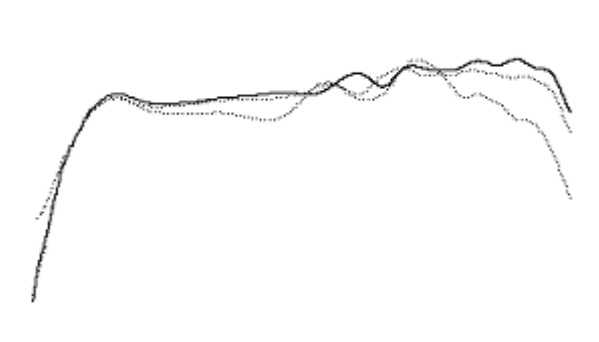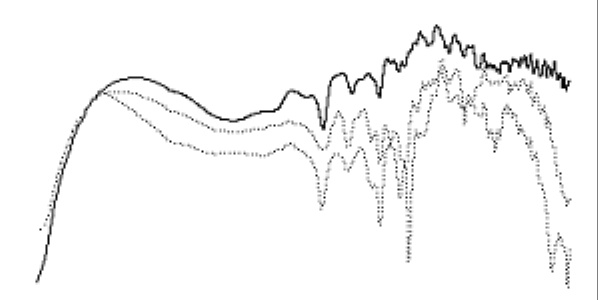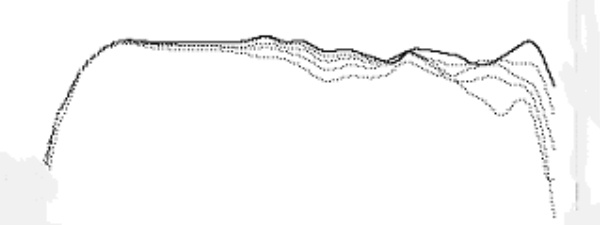Center-Channel Speakers: What the Industry (Even the "White Hats") Often Refuses to Tell You
- 04 Apr 2005 17:06
- 1232

What’s wrong with two-channel stereo? The main problem: it’s a sweet-spot deal. Good spatial rendition requires that listeners sit on the centerline. Off-axis listeners get nearside bias—the stage and images follow them to the near speaker. Farther phantom sources, even for centered listeners, have a midband response-error characteristic (the Holman dip) and tend to produce soft, foggy images. While the latter characteristic is often preferred by artists because it helps mask vocal or performance deficiencies, it lessens accuracy of reproduction in home systems.
The biggest potential advantage of multichannel audio—and I’m not limiting myself to music only—is a stable soundstage with excellent placement and tracking of moving sound sources, a soundstage that doesn’t shift with listener position, perverting timbre, location, and direction, but provides an improved sense of ambience and envelopment. Two-channel playback is similar to looking into the performance space as opposed to being in it. In other words, with a high-performance multichannel recording everybody, even off-axis listeners, get a soundfield that doesn’t have to be dependent on listening position. It’s much easier to “go to the performance” with multichannel.
Because center stage is the primary focus of program content of practically all recorded sound, the center-channel speaker then becomes the single most important speaker in a system. It needs to have a flat response characteristic (natural timbre) and, because it services off-axis listeners and provides another sidewall first reflection into the listening area, it needs to have smooth off-axis response as well.
My observation about sound systems is that very few of them, including two-channel systems, use dead center as a listening position, except for occasional monitoring or demonstration purposes. Solitary listeners will often sit 10 to 15 or more degrees off axis. Auxiliary listening seats may be as far as 30 to 45 degrees off center. Few people, even those that are hardcore two-channel listeners, use a sweet-spot-only strategy. This further emphasizes the importance of center speakers for modern systems.
Looking at the market, I’ve found that nearly all center-channel speakers have a low, wide profile using an MTM—often called D’Appolito—array, with a pair of 4", 5.25", or 6" woofers flanking a dome tweeter. This style is decor-friendly, has a better partner acceptance quotient (PAQ?), and is physically well suited for perching atop a large-screen rear-projection display. While the driver layout of these speakers is sometimes called a D’Appolito array, few of them fit the criteria of the originator as to driver spacing, crossover frequency, and final response.
These speakers, even the better ones, have a universal characteristic: strong, sometimes severe, lobing in the horizontal plane, which will be launched into the listening area either through reflected sound or direct radiation to off-axis listeners. Fig. 1 displays an example of a typical, currently sold, MTM center channel speaker. Lobing begins at 7.5 degrees and by 22.5 degrees is quite strong. This is a sweet-spot device!
Fig. 2 and Fig. 3 are examples of a “better” MTM sold as a left-center-right (LCR) model for use at all channel locations. Used vertically, it has smooth, even response. Used horizontally, lobing is quite evident and, in my opinion, prevents this speaker from delivering an acceptable level of performance for use in a high-quality playback system that aims to accommodate anything but a single-listener sweet spot.
A few manufacturers address this condition. Fig. 4 and Fig. 5 show an MTM speaker that uses an offset tweeter. The tweeter is located above the line that connects the centers of the woofers. This particular speaker is also billed as an LCR model; the layout is the same for left, center, and right, with the center channel used horizontally. Fig. 6, also a two-way speaker, has a differing layout of horizontally arrayed drivers. Performance as a center channel is quite good, although the speaker is about the same “height” as a small vertically arrayed two-way speaker. Because of the unusual driver layout, directivity is somewhat different to the left and right sides of the speaker.
A few manufacturers make a coaxial center-channel speaker. Coaxial speakers usually have response anomalies caused by mounting the tweeter on a post that extends from the pole piece in the location where the dust cap would normally reside. Some of them use a tweeter that is suspended from a clip or assembly attached to the frame at the edge. This also causes acoustic shadowing, although it often works better than a post mount. One manufacturer uses a coaxial driver with the tweeter located where the dust cap is typically found. This is a logical extension of the coaxial idea, but every one of these devices I’ve used suffers from a response deviation at higher frequencies, which seems to be related to reflections from the tweeter radiating up the cone. A number of years ago DCM (the old DCM, not the Mitek company that currently markets the brand) had a coaxial speaker in which the tweeter was offset and mounted on a mesh screen in front of the woofer. As I recall, it worked pretty well. I wonder whatever happened to that idea?
Occasionally I run across a 2.5-way MTM system where one of the woofers is a passive radiator. These systems also display lobing, as will a 6.5" two-way when you lay it on its side, but performance varies to the left and right sides of the speaker. The basic problem remains: drivers operating side by side will show driver interference (off-axis lobing) in the crossover area where they are both operating. When the flanking drivers cover differing frequency ranges, directivity will vary left to right.
One method enthusiasts use to address a problem is simply to throw money at it. Fig. 7 shows a heavy, much larger, high-cost solution using exotic drivers. If you are rich enough, you too can buy a poor-performing channel. Just get out your checkbook. As a rule of thumb, hurling money at an audio problem or dilemma is nearly always a fast track to worse performance. In this case, the speaker has fairly uniform directivity—response is equally bad at all radiating angles.
I’ve had the opportunity to test hundreds of different loudspeaker systems over the past decade. From 80 to 100 Hz upward, the best systems—and I mean best in an absolute sense—have been 6.5" two-way designs. The speaker graphed in Fig. 8 is among the finest I’ve encountered. As you can see, it has tightly controlled directivity in the horizontal plane out to 60 degrees. This means that all listeners get the same basic sound quality, and reflected sound will be returned with the same timbre. There is a relatively small amount of lobing in the vertical plane, which means that this speaker sounds best vertically placed, and that’s how I use it. This cabinet is only 14" tall, looking almost graceful perched on a 50" rear projector, but hidden behind a 115" perforated screen even that doesn’t matter. What’s the downside? It doesn’t have adequate dynamic capability below 80 Hz. So what? If this were a full-range speaker, in the truest sense, I’d cross it over at 80 Hz anyway because center-channel placement always compromises bass performance.
Two-way speakers by manufacturers such as Paradigm, PSB, Polk, NHT, JBL, Boston Acoustics, and Infinity make excellent center-channel choices, often at remarkably low cost. The optimal center-channel speaker choice will usually be a good-quality, vertically deployed 6.5" two-way speaker. Good sound, even greater value.
One problem with this idea is that dealers are generally reluctant to sell these speakers in quantities of one. You generally have to buy a pair. But at these prices, why not? Better yet, can you dig out one of those 5.25" or 6.5" two-ways you have gathering dust in the basement?
Dedicated center-channel loudspeakers are designed and marketed as horizontally arrayed, low-profile, gracefully styled accessories for large-screen television. While the inclusion of a pair of woofers improves low-frequency capability, few of them will deliver an honest 40 Hz at the listening position and, frankly, there is no need for them to do so. They offer no other performance advantage, and most lack acceptable sound quality for more than one listener.
I’m amazed at how few people, even “the good guys in the white hats,” ever mention the disadvantages of the typical low-rider center channel. Even the best companies with the smartest designers seldom talk about this issue. They seem to be happy with performance that fits into a relatively narrow listening window and happily sell thousands of low-riders. Major magazines don’t seem to be interested in an exposé of the issue (“too technical”). High-end publications stubbornly cling to stereo. Still others subscribe to the unfortunate scheme of five full-range speakers with a single central listener, which is killing DVD-A and SACD.
The film people have always dragged the audio crowd kicking and screaming into the future. Where did most people first hear reproduced sound? Radio, of course, but that’s the last time that audio was a frontrunner. Stereo? At the movies. Dolby surround? At the cinema. True multichannel sound? THX-certified theaters. Dolby Digital, followed by DTS, is still the de facto multichannel standard.
Furthermore, film soundtracks are purposefully designed to accommodate an audience, a large audience. By contrast, many DVD-A and SACD recordings are mixed without a center channel, so we still get a stage that moves with the listener. Many are mixed according to the five-speaker format with the mixer centered in the sound field, so the end user is expected to use the same playback scheme.
Personally I love surround sound. In fact, I can’t live without surround sound for either movies or music. I also love having girls over for movies and music. So I’m just amazed that the DVD-A and SACD folks haven’t figured out that most customers no longer use the “motorcycle” paradigm for entertainment. (You can get more than one person on a motorcycle but only one gets to “ride” it.)
I’m a big fan. I hope this discussion will help you to make choices about the most important speaker in your multichannel system.
Graphs:
The solid traces represent on-axis (0°) response. The dotted traces are horizontally off axis at 15° intervals.

Fig. 1: A modern center-channel speaker. Note the lobing that starts dead center and gets more severe as radiating angle increases.

Fig. 2: Speaker is used vertically at all channel positions except center. Response is quite good—flat spectrum, well-controlled directivity.

Fig. 3: Same speaker as in Fig. 2 but used horizontally. Note the lobing near the crossover, which begins quickly and becomes relatively more severe at wider radiating angles.

Fig. 4: Used vertically, this LCR model with offset tweeter has a good spectrum and reasonably well-controlled directivity.

Fig. 5: Used horizontally, the same 3-way LCR with an offset tweeter actually works better than when vertically placed.

Fig. 6: This speaker uses an unusual driver layout. It has good performance but is still about a foot high in the horizontal position. Response is similar for both center-channel and other-channel use. However, the unusual layout means the speaker has somewhat different response to the left and the right .

Fig. 7: This expensive system with exotic drivers has somewhat uniform directivity but little else to recommend it.

Fig. 8: This vertically arrayed model has a flat spectral character and tightly controlled directivity to 60° off axis. Because it has a single 6.5" woofer, SPL capability below 80 Hz is diminished.
